Neolithic delivery rooms
Sleeping Lady
This beautiful and refined sculpture of a sleeping woman is from the Hypogeum in Malta and of about the same period as the megalithic passage chambers of the British Isles, that is 5000 years old. The Hypogeum itself is an extraordinary structure and comes closest in architecture and sophistication to the Maeshowe group in Orkney, but it has not got the same kind of geometrical discipline as we see it in Orkney. On the other hand the refinement and expression of this sculpture is unparallelled in the Stone Age, as far as I know.
In my view this figurine depicts the blissful sleep of a woman after childbirth, sleeping on the child bed.
The woman is in the prime of her life, a symbol of abundance and readiness to feed. We see a striking resemblance in the shape of the basin on which she is lying, with the basins found in the Irish chambers. (see below)
My painting inspired by Queen Maeve (Knocknarea) and
Loughcrew, chambers covered with quartz stones
Child beds
At long last I publish here one of the major themes of my lecture for the Orkney Archaeology Society in 2009, which concentrated on a specific use of the megalithic chambers, apart from their refuge function, that is, that of delivery room for pregnant women. See this against the background of the very high mortality rate of women, which may have been exacerbated by very young women becoming pregnant. This would explain the sometimes seemingly small size of the child beds, but also women would be smaller in general.
The famous sleeping figurine of Malta also shows the relatively small size of the child beds and the universal form they seem to take. The hollow form is ideal for childbirth, considering the material, but not for a regular bed.
The idea of women in childbirth in the chambers came to me as a natural consequence of prolonged refuge in the chambers, especially during the cold winter months. Nature does not wait and childbirth comes when it comes, also under severe weather conditions.
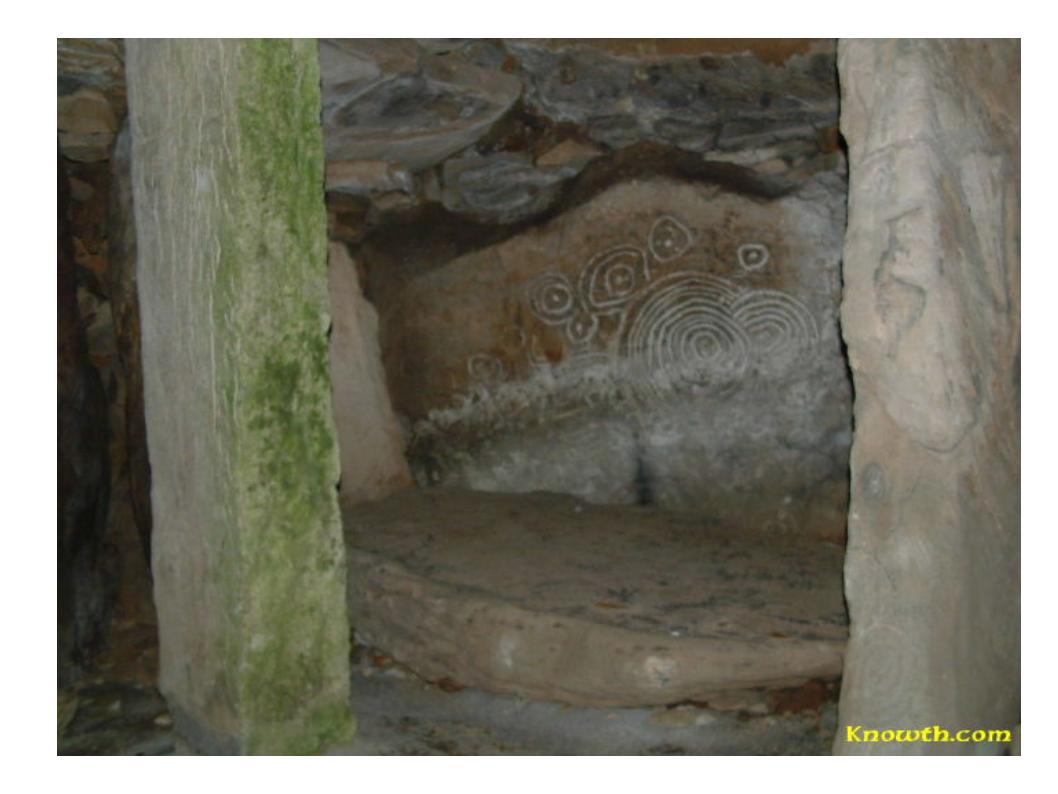 The idea of a child bed occurred to me first when I saw the pictures of the stone basins of Loughcrew, Dowth and Newgrange, so very unlike the round or oval shaped basins of the well-known pictures; these other basins were big and elongated and immediately gave me the association with a bed. Suddenly the two came together in the placement of the basin in cairn L, its privacy, and the interior compartments of the whole chamber where the many compartments could hold sitting/sleeping midwives attending at the birth-process and the aftercare.
The idea of a child bed occurred to me first when I saw the pictures of the stone basins of Loughcrew, Dowth and Newgrange, so very unlike the round or oval shaped basins of the well-known pictures; these other basins were big and elongated and immediately gave me the association with a bed. Suddenly the two came together in the placement of the basin in cairn L, its privacy, and the interior compartments of the whole chamber where the many compartments could hold sitting/sleeping midwives attending at the birth-process and the aftercare.
In Orkney it was tradition until recently that up to 6 midwives were involved in childbirth and aftercare, and the Orcadians are one of the few long isolated populations of which it is practically sure they go back to the Stone Age and the builders of the chambers, they may even go back to the first settlers in the basin of the present North Sea. This is my conclusion upon reading People of Orkney,1986. Some traditions are timeless.
The plan of Cairn L at Loughcrew (enlarge) is the most convincing lay-out for a delivery room, with up to 7, one-person recesses or some, possibly, spaces for smaller basins (cradles). This specific chamber would initially have no other function than being a maternity clinic, it differs significantly from the other big chamber at Loughcrew, Cairn T, which has the observer-unit design of a communal space with 3 recess facilities for 3 individual nighttime observers, who did not make a fire so as not to impair their eyesight.
Cairn L is surrounded by 41 kerb stones, 41 being half of 82, the number of 3 sidereal/tropical moon cycles of 27.32 days and thus the exact number of days in the ideal rhythm of 3 female fertility cycles. (Conwell counted 42, Jean McMann 41 stones, I bet on Mc Mann).
It is of some importance to note here that the female fertility cycle is not related to the apparent relation between earth and moon, 29,5 days (synodic or lunar month), but derives from the cycle of the moon in relation to the solar system (tropical month 27,3215…days) or the fixed stars, the universe (sidereal month 27.3216…days). This in my view shows that the highest principles of life relate to the solar system or the universe, not to the earth itself.
This would suggest that the laws of life are universal instead of earthbound; this does not necessarily mean there must be extra-terrestrial life forms, although it does emphasize that living nature reaches beyond the earth.
 Dowth North would have been an operation theatre.
Dowth North would have been an operation theatre.
The basin in Dowth is special because it is in the middle of a larger space, around which some six people could be grouped. These would be needed to keep the patient under control which would no doubt suffer a lot of pain during the operation. We know they did operations.
Dowth North stone basin
I now sincerely think that all the main chambers mentioned here had a clinical function, and that the round basins were also used as washing basins, they are usually in secluded spaces (pillars!, see pictures). Cairn H (Carrowkeel), cairn L (Loughcrew), Knowth, Dowth north, Newgrange (Boyne Valley) and Maes Howe, possibly Vinquoy Hill (Orkney), it were all (partly) clinical facilities and when not in use as such, they would have been used as living spaces by the astronomers, the scientists, who were awake during the night and slept during the day and who would have been the skillful builders of the well-thought through multifunctional spaces in the first place.
These chambers are all in big mounts and often have a central position in a gathering of other smaller chambers. The point of the massive mount is that: the bigger the mount, the bigger the mass, the more even the temperature inside all year long. It probably never freezes inside a dry passage chamber, even without closing-off the passage by a stone or hides. Maeshowe’s stone door is closed from the inside, with about 10 cm air space above it; it has not been recorded yet, that the dead need fresh air or that they close their own burial chambers; and every bit of its architecture is functional in Maeshowe. Unfortunately there are very few untouched original chambers left with that unspoiled quality; but there are a few.
Many of my ideas and theories can be scientifically tested and verified or falsified, that is what makes them interesting to me.
This work is not meant to add a few interesting new ideas, but to make a real difference, that is why I hope I can challenge people to prove me wrong.
We are talking here about an important change in perception of the late Stone Age culture from primitive, savage, pagan barbarians into sophisticated scientists and architects (no priests, rather wizards or shamans). I am not the first to claim this, but I think I have gathered what are among the best and most convincing evidence and arguments.
Many of the so-called foundation burials I view as regarding people who died by accident in the process of building the chamber or stone circle (these can also be children) and thus were honoured as a sacrifice towards the eventual beneficial use of the building, this would enhance the power of the place to protect and benefit the community.
I don’t know of any strong evidence of human sacrifice in the late stone age or, specifically, the original megalithic culture, which probably died out in spirit with the improving climate after 2900 BC and with the end of the use of the chambers as communal survival centres. On the British Isles this spirit, though, may have survived longer than on the continent.
It is in the ensuing period that some chambers started to be used as burial places, but given the enormous span of time the chambers were used, from hundreds up to maybe a thousand years, the amount of bones in them is usually scant and of the later phases, the interments sporadic.
It is also only for a certain period that churches became used as burial places, but that does not change churches into tombs, other than in a technical sense. The chambers had a variety of functions when built, which we can infer from their different architecture, but the created space was for the benefit of the living, not for the burial of the dead.
And that is, of course, what makes the most sense any way.
Knowth East stone basin, note the outside stone carving which can easily be associated with childbirth, the carving in the inside of the basin can be seen as a sun rising (east) between hills, but also as a head emerging from a womb.
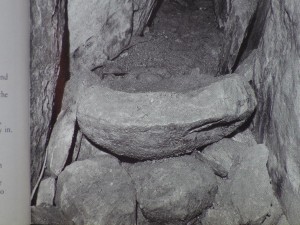 Knowth West stone basin, slightly propped up
Knowth West stone basin, slightly propped up
and tilted, in the passage
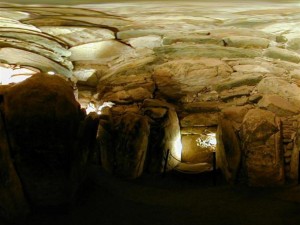 Inside Newgrange, the left-hand stone basin in its recess
Inside Newgrange, the left-hand stone basin in its recess
This could have been an ordinary sick bed, just like the
similar bed in the end recess
See the excellent 360 degree overview of Newgrange at:
Newgrange Central Chamber – County Meath Ireland
 Inside Newgrange, the right-hand stone basins, in the recess
Inside Newgrange, the right-hand stone basins, in the recess
This would have been the delivery room, Newgrange as a whole would be a clinic, with three beds
Note the uprights which make it a more private space, as in Cairn L and Knowth East.
 The indentations at the left hand side of this small basin (enlarge), – on top of another basin in Newgrange (see picture above)- could be hollows for the young woman to place her heels.
The indentations at the left hand side of this small basin (enlarge), – on top of another basin in Newgrange (see picture above)- could be hollows for the young woman to place her heels.
I know too little about childbirth to give a judgement on the suitability of the basins for childbirth but the figurine of the Hypogeum (Malta) can be placed in the same context, also on a relatively small oval shaped basin. Important is the multifunctionality of the basin, as child bed, as cradle, as washing basin and as resting place, these functions can be changed instantly.
I believe in the multi-functionality of many of the Stone Age artifacts and also of the huge chambers, which were originally essential places for survival of communities, plagued by alarming demographic imbalances in a deteriorating climate.
*****
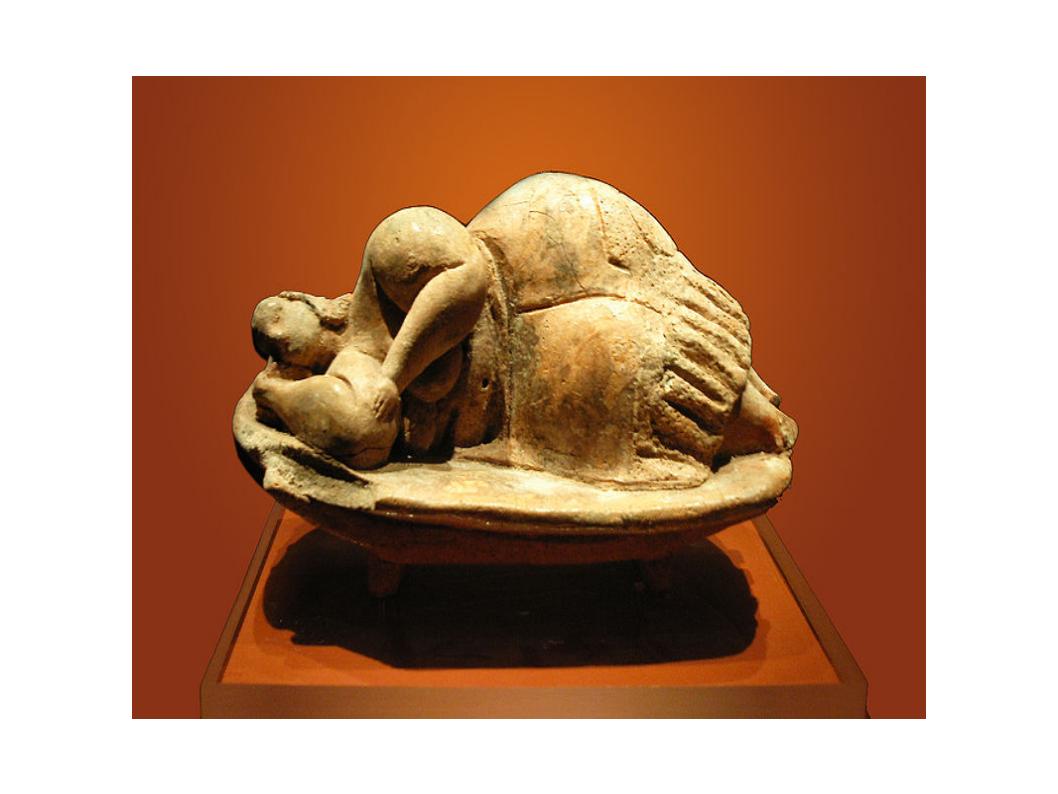
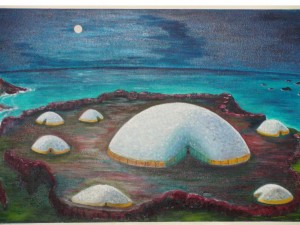
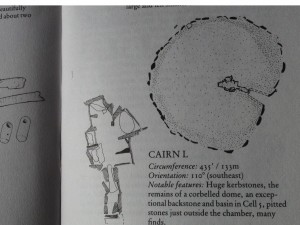
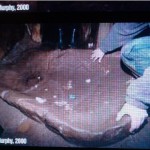
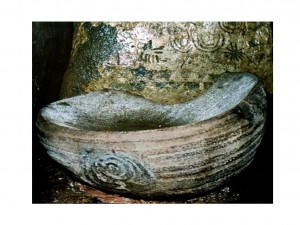
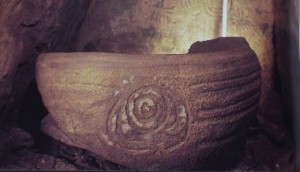

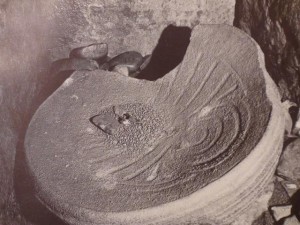
In my new book set in the year 3150 BCE, the protagonist gives birth on solstice morning of that year at Newgrange and on what I called the birthing basin. The soul of her grandmother is carried from her remains that lie in the left chamber to the newborn by the light of Venus when it enters the roofbox shortly before dawn. I am so pleased to see this figurine which gives credence to the way I visualized what passage chambers were used for. Thank you for posting this and the commentary.
This could make the Cailleacht the head matron/ midwife…
A very important person…
Hmmmm
Would sheila na gigs be where maternity clinics were located…
Or fertility clinics. Like Planned Parenthood centres (here in the US)
Provoking thoughts. Interesting ideas.
Possibilities.
I would very much like to speak with you or correspond. Back 18 years ago, I was visiting Ireland from the US. I went to Newgrange and Knowth. I had a phenomenology (a term I just learned today). I did not know what it was I experienced but it was a lucid vision/dream while I was there. It was so intense, I fell to the ground. I am not a new-ager, or believer in such things. I am a university professor, and base my thoughts in science.
Anyway, I went inside the Knowth mound and the guide was explaining how they thought it was for burial purposes. I immediately interjected: “that is wrong, this is a birthing chamber; a very great king was born here, and it is an auspicious place to have your children.” I jumped into the basin and showed him how a woman would sit in order to give brith and how the basin was not only to catch the baby but the placenta which was used for ceremonial purposes. To say he, and the other visitors were surprised was an understatement, but I was surprised more. I had no idea what compelled me to say what I said, and do what I do. It was like I was simply explaining a truth that needed to be told. The guide said that I had a unique idea, one worth thinking about. I asked him if they had found the infant bones buried around the mound. Those were from all the babies who didn’t make it, some still born, others miscarriages, etc. He said there were indeed baby bones and how did I know that. I told him, because I was here before.
I have never followed up on that bizarre event. Outside, when I fell to my knees, I remembered being there, with my brother, who was also my husband. I had vivid flashes of fighting, and day-to-day life. I had come there to give birth. There were many people there, all women waiting to come to deliver.
Again, I do not want to sound like a kook. I have never shared this with but a few friends, but the visions of that life now haunt me. I see them in my dreams, and I feel them in my bones.
I hope that I may communicate with you to find out more of your ideas, and let you know what I “know” from my memory of that past experience. As a woman of knowledge and higher learning, I can assure you, I am not looking to exploit my time talking to you. I simply need to share this knowledge and when I shockingly came across your site, I was very excited. Best, Muara C. Johnston
Muara, I am also a woman of higher learning, a licensed physician. I too have had visions of the history of Newgrange. I visited there many years ago and felt deep in my bones this it was a birthing chamber. The mound is literally the manifestation of a swollen pregnant womb with the birthing canal being the passage. Many years later, last night to be exact, I had been thinking about Newgrange in my mind before sleep and decided to let me mind and spirit (?) take me to the site. I immediately saw a flash of a naked couple having intercourse, another flash of a woman giving birth, another flash of her taking her own blood and walking along the chamber walls and spreading the blood on the rock with her hands, giving gratitude to the earth mother. It was a very profound and a beautiful vision. I was very thankful to have been given this possible glimpse into its history.